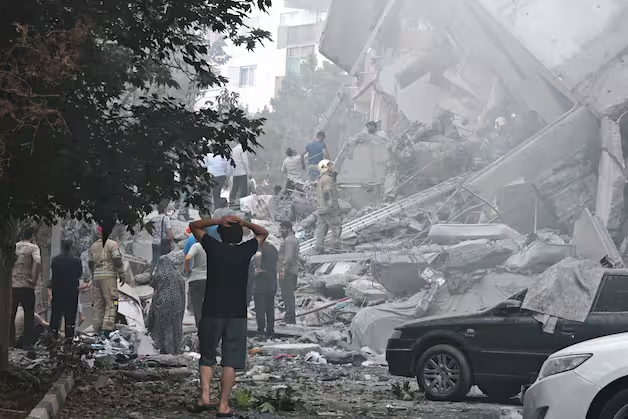Indianapolis – In the blinding flash of geopolitical conflict, as missiles streak across the Middle East and command the world’s rapt attention, it becomes tragically easy to lose sight of other, more intimate apocalypses. But for 241 families scattered across the globe, from the bustling suburbs of London to the quiet towns of Gujarat, the world did not shift its axis because of a war declared between nations. Their world ended when Air India Flight AI-171, a Boeing 787 Dreamliner bound for London, fell out of the sky.
In the space of a few horrifying minutes, the modern miracle of flight became a vessel of unimaginable sorrow, plummeting into a medical college hostel in Ahmedabad and extinguishing 241 souls. While the headlines may have moved on, drawn by the gravitational pull of state-on-state warfare, an ocean of grief remains. It is a grief felt by the first responders combing through the smoldering, unrecognizable wreckage; a grief felt by a corporation, Tata Group, whose ambitious reinvention of a national airline has been irrevocably scarred; and a grief felt most acutely by those who now wait for a DNA test to confirm a loss their hearts already know.

The passenger manifest of Flight 171 tells a story of a deeply interconnected world. There were 169 Indian nationals, many of whom were visiting family or, like former Gujarat Chief Minister Vijay Rupani, traveling abroad. There were 53 Britons, seven Portuguese, and one Canadian, each with a story that ended abruptly in a plume of fire and jet fuel. They were families returning from holidays, couples hoping to start a new life, and individuals on business. Now, they are a statistic in a tragedy that, in a less chaotic week, would have dominated global news for days.
Amidst the totality of the loss, there is the confounding story of the sole survivor. Vishwashkumar Ramesh, a British national, was pulled from the wreckage in seat 11A. His survival is a statistical improbability, a sliver of light in an abyss of darkness. His first coherent words to rescuers—a memory of a “loud noise” just after takeoff—are the first clue in a desperate and complex search for answers.
That search is now officially underway. As is standard, the investigation is a multinational effort, led by India’s Aircraft Accident Investigation Bureau (AAIB) with heavy involvement from America’s NTSB and FAA. The recovery of the “black boxes”—the cockpit voice and flight data recorders—is a crucial first step, and officials have confirmed they are in hand. Yet even before that data is analyzed, video of the aircraft’s final moments presents a mystifying and deeply troubling picture for aviation experts.
The footage shows the Dreamliner, an aircraft with a previously impeccable safety record, in a bizarre and dangerous flight configuration. Its landing gear is down, yet its wing flaps appear to be retracted. In the takeoff and initial climb phase of a flight, this is the aerodynamic equivalent of trying to run a sprint with your shoelaces tied together. The flaps are essential for generating the lift required to climb at lower speeds; without them, an aircraft can stall and lose altitude catastrophically.
This visual evidence has sent investigators down two primary paths: a catastrophic mechanical failure or a fatal human error. Did the hydraulic or fly-by-wire systems that control the flaps fail? Or was there a breakdown in cockpit procedure? These are the questions the data from the black boxes will be expected to answer.
Complicating the narrative is the specter of the manufacturer, Boeing. The crash of the first 787 comes at a moment of intense crisis for the aerospace giant. Years of scandals surrounding its 737-MAX, coupled with harrowing whistleblower testimony alleging shoddy production practices and safety shortcuts on the 787 assembly line itself, provide a disturbing context. It is impossible to view this crash in a vacuum. A mechanical failure on this aircraft cannot be dismissed as a simple one-off; it would be seen as the potential culmination of a documented and deeply compromised corporate culture. Already, India’s aviation authorities have mandated enhanced inspections on all of Air India’s 787s, a clear sign of a loss of faith in the machine.
Yet, as investigators focus on the mechanical and the procedural, a darker and more unsettling question lingers, one that officials seem pointedly unwilling to address: why is terrorism not higher on the list of publicly discussed possibilities?

The explosion, as seen in amateur videos, appears to originate well behind the aircraft’s wings. A catastrophic engine failure or compressor stall would likely present differently. While it is true that investigators must follow the evidence, and the most immediate evidence is the plane’s aerodynamic state, the silence on other possibilities is conspicuous. Is this a deliberate effort to prevent public panic, a standard operating procedure until hard evidence of a device is found? Or is it a genuine reflection that, in this specific case, the known issues with the manufacturer provide a more plausible, if equally terrifying, explanation?
We may not know the answer for months, if not years. For now, the story of Flight AI-171 is one of profound and overlapping depressions. There is the depression of the families, grappling with a loss so sudden and absolute it defies comprehension. There is the depression of a company, Air India, that saw its hopes for a new beginning consumed in a fireball. And there is the quiet depression of an industry that, once again, must confront the terrifying fragility of the machines it sends into the sky. While the world’s attention is captured by the loud, bombastic tragedy of war, we must not forget the quiet, devastating tragedy of Flight 171, and the 241 souls who deserve to have their story told and the reason for their deaths.
Discover more from Clight Morning Analysis
Subscribe to get the latest posts sent to your email.










